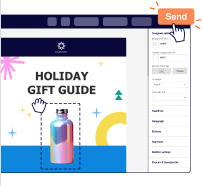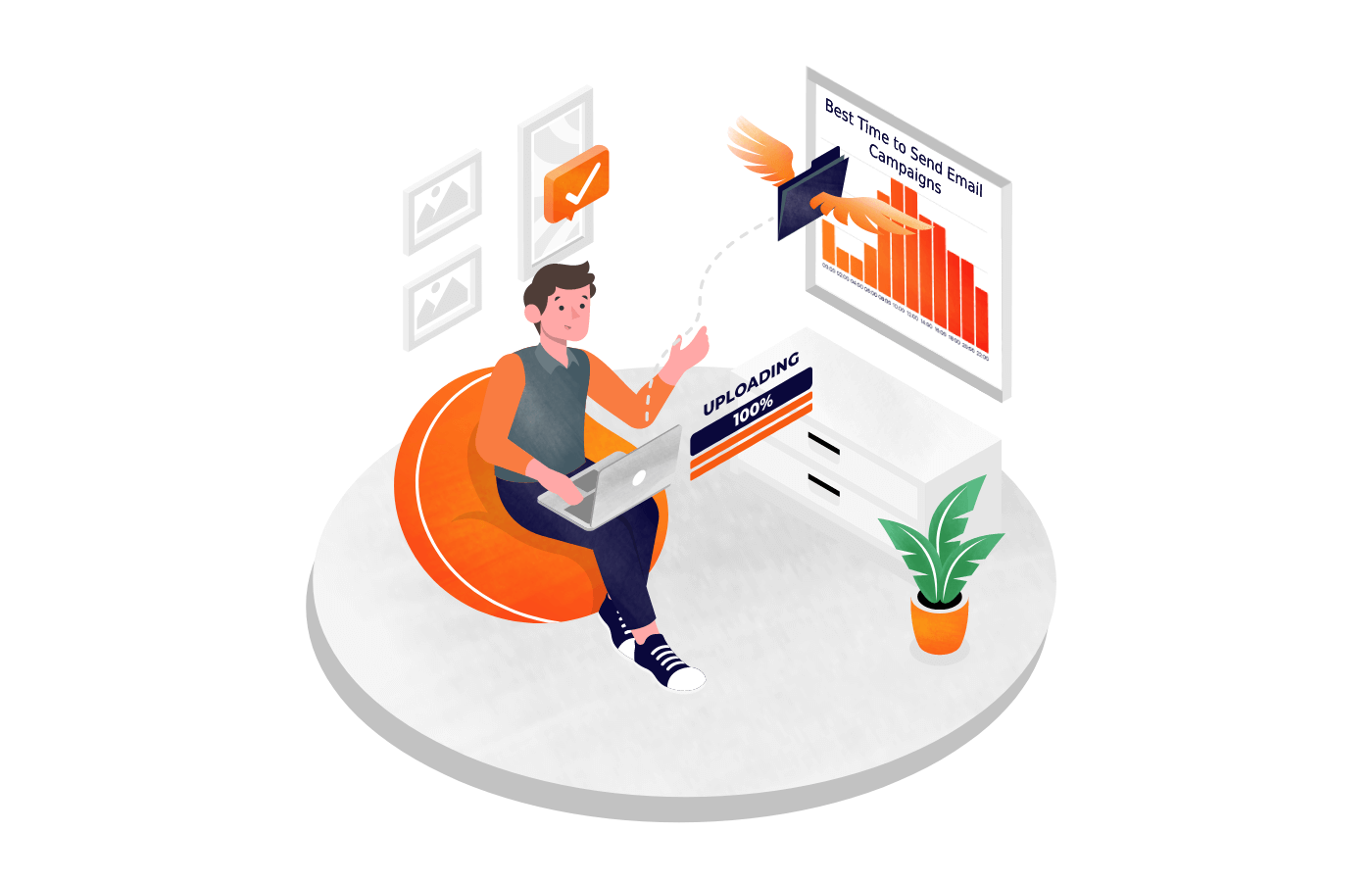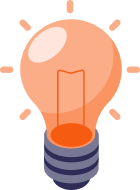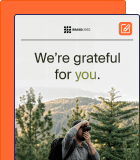Such little things as when the subscribers receive your email can make or break your email marketing performance. When one-fifth of all emails are read within an hour, deciding which hour of which day it will be is crucial. After all, it influences such key metrics as click-through rates, click-to-open rates, and open rates.
These performance-measuring trackers can inform you whether your EDM (electronic direct mail) marketing is working or just sucking money out of your business.
So, how do you bulletproof your email marketing campaign send time so your audience is hooked instantly and hits the CTA button? You determine when your audience or community will engage with your email depending on the message’s type and purpose, your audience’s own time zone, and digital behavior.
Let’s look at the best time to send emails based on the email campaign and other factors one by one in this blog post.
Best Time to Send Marketing Emails
Let’s admit—everyone’s email inbox is packed with stuff they don’t read. On average, two-thirds of people have unread emails in their inbox—1602 of them.
How do you plan your campaigns in a world where emails are ignored? A logical assumption is that emails at the top of your subscribers inboxes will likely be viewed and opened. So, you need to time them well. Here are a few insights:
- Your send time by industry should depend on the specific sector you’re operating in;
- Tuesdays and Wednesdays are the best day to send emails for B2C and B2B companies;
- Sundays are the least effective days to send campaigns for a B2B brand. However, if you choose to email at the end of the week, anyway, the best time to send email blast on Sunday is past 4 p.m.;
- Test different send times and let your data decide when your audience is most active through email automation tools.
Launch email campaigns with ease with Sender. Use features like drag-and-drop builder, automation, segmentation and more—completely free.
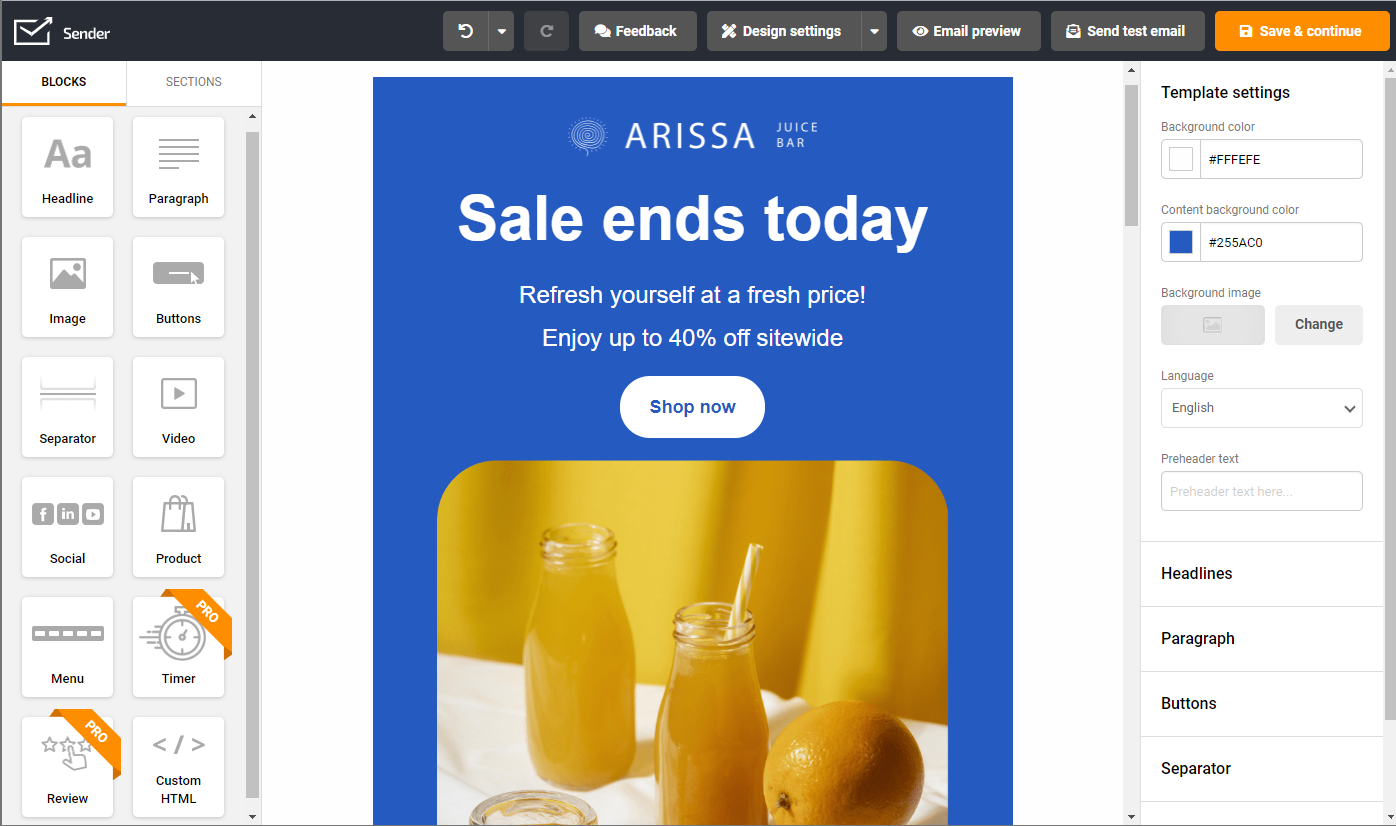
Why Does Email Timing Matter?
Sending an email at the right time can potentially improve your email campaign success rates. Timing the messaging well helps you stay relevant, be seen more often, and achieve better engagement with your subscribers. Here are some of the reasons why optimal email sending time matters:
- Improved open rates. Knowing when your subscribers are most active and timing your campaigns around that time helps improve the odds of your email being opened during peak email open times.
- Maximized click-through rates. When your audience is engaged, they’re most likely to click on links within your email. So, timing based on user activity matters a lot in increasing click-through rates.
- Heightened competitive standing. Your audience will appreciate your thoughtfulness when they receive the right email at the right time. This will give you a competitive edge and increase your value in their life, which will help defeat competing for their attention with other brands.
- Increased target audience reach. Your target audience will appreciate you for sending an email when they want to read more about you. Plus, it increases the chances of referrals, increasing your reach and email engagement.
Best Time to Send Email Newsletter by Type
Each type of email comes with characteristics that dictate the right time you can send it. For example, you’ll want to send an invitation email a few weeks before the event, a survey email when you want feedback, and an abandoned cart email a few hours after.
The type of email commands the optimal time decision in email marketing. Here is a breakdown of the best time to send sales emails and newsletters according to the type:
Newsletters Emails
For US-based subscribers, the best time to send email newsletter content is during daytime or late evenings when people can read before bed. Avoid Thursdays and Saturdays as they receive the lowest open rates.
The best time to send email campaign on Monday, Wednesday or Friday is between 3:00–7:00 a.m. in the early morning or after late afternoon. However, you might not see immediate opens until days later.
The sweet spot for newsletters is between 10:30-11:30 p.m. or 3:00-6:00 a.m. when recipients start their day. For maximum impact, the best time to send emails on Friday is between 3:30-5:00 a.m., which can achieve up to 25% open rates.
Avoid sending between 9:00-11:00 p.m. on Saturday for US subscribers, as this yields below 20% open rates.
Key Takeaways:
- Best days: Monday, Friday, Wednesday
- Best time: 3:00–7:00 a.m, 6:00-11:30 p.m.
Mass Emails
Unlike carefully crafted newsletters, mass email blasts are more sporadic. Track your audience’s online behavior and segment lists based on activity patterns to determine the best time to send email blast for your specific audience.
For general guidance, the ideal time to send email campaigns falls between Friday and Monday when recipients are most likely to open them. The peak engagement window is 10 a.m. to noon, during mid morning, when people take breaks and check inboxes. This window can extend until 4 p.m., but engagement drops significantly after 6 p.m.
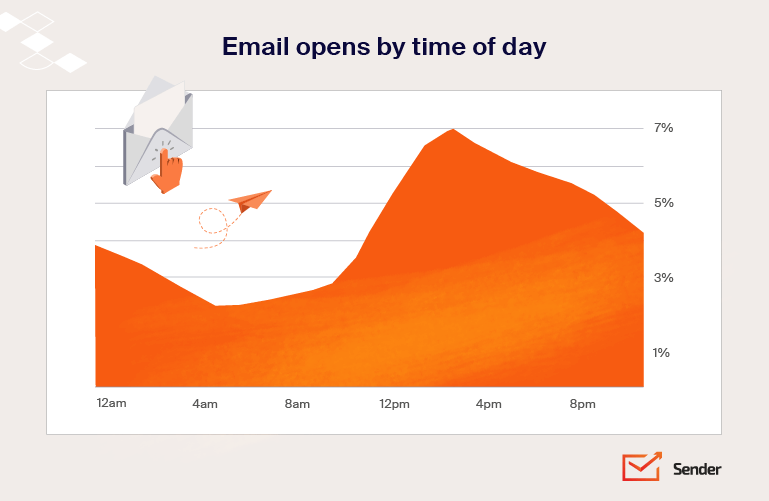
You can still send promotional content or event announcements outside these hours if you know your audience’s habits. Use A/B testing and consider implementing auto resend features to better understand customer behavior patterns across all email types.
Key Takeaways:
- Best days: Friday to Monday
- Best time: 10:00 a.m.—noon, 2:00-6:00 p.m.
Promotional Emails
Brands generally send promotional emails as and when they please. But there are better strategies than that, especially when you want to improve your email marketing KPIs. Scheduling promotional emails at the right time helps increase CTR (click-through rates) like any other email campaign.
Since promotional emails are unsolicited, you should make them instinctive (and spontaneous) for the recipients to open and read. So, scheduling them when subscribers are on their devices is best, or you risk getting lost in a crowded inbox. A compelling email subject line combined with proper timing maximizes your chances of engagement.
The best time to send email on Friday is at 11.00 a.m. This time is perfect for maximum engagement if your subscribers are US-based. Remember, always research your audience and use the following tips to get the best results:
- Test multiple time slots to find the best hour to send emails as per your audience;
- Analyze open rate, clickthrough rate, and engagement data to find the best times using Google Analytics and other tracking tools;
- Adjust sending times for holidays and relevant events;
- Personalize content, offers, and subject lines for higher engagement and consider implementing smart sending features.
Key Takeaways:
- Best days: Friday
- Best time: Around 11 a.m.
Transactional Emails
Transactional emails include order confirmations and other post-interaction messages. While the instinct is to deliver emails immediately after a transaction, timing strategy can improve engagement and avoid overwhelming customers.
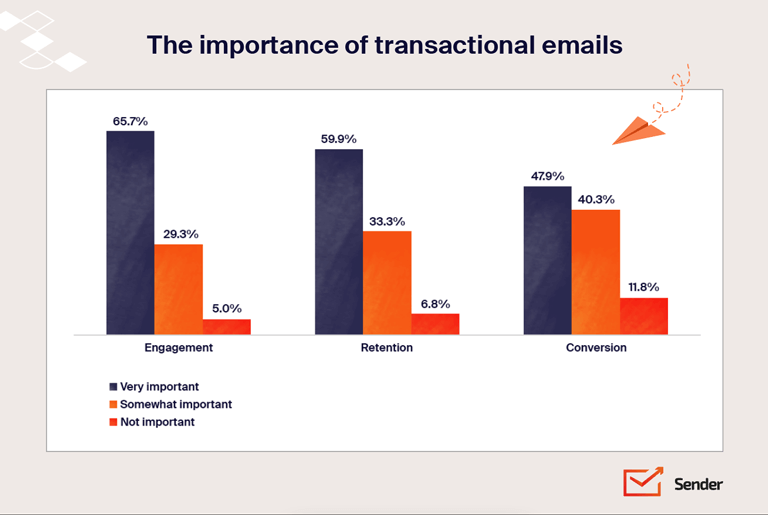
Send confirmation and password reset emails immediately after the transaction occurs. However, the best time to email customers with abandoned carts can be optimized based on these guidelines:
- Send the first reminder within a few hours as a gentle nudge
- Send the second email 24 hours later, giving customers time to reconsider
- Send the final email one week later with a discount incentive
This approach addresses trust issues, high shipping costs, or technical problems that may have prevented the initial purchase without appearing pushy. Many marketing services now offer automated sequences for this type of timing strategy.
Key Takeaways:
- Best day: Same day as the transaction
- Best time: A few hours after the transaction
Welcome Emails
Welcome emails achieve some of the highest open rates, jumping from the typical 15-25% to around 50%. According to Marketing Sherpa, they’re 86% more successful than newsletters, making first impressions crucial.
Follow this 3-step welcome sequence:
- Send the first welcome email immediately after signup while your brand is fresh in their mind
- Send a second email based on whether they’ve made a purchase—continue the welcome series or switch to transactional emails
- Send the final welcome email two days after the original, ensuring they receive your intended message and convert
For complex offerings like tech startups or payment processors, you may need more than three emails to convey your message effectively. Adjust the sequence length based on your business complexity.
Key Takeaways:
- Best day: Same day as subscription
- Best time: A few hours after subscribing
You might also be interested in these 27+ appointment email examples that will make scheduling appointments way easier.
Email Follow-ups
Follow-up emails are highly time-sensitive and can yield excellent results when executed properly. Understanding email habits by different groups shows that surprisingly, not many companies follow up with potential customers, representing a massive missed opportunity.
Key timing strategies for the best time to send email for response:
- If customers contact you first, respond promptly;
- If you’re initiating contact and haven’t received a response, wait 3-4 days before following up;
- Avoid Mondays and Fridays for follow-ups;
- The best time to send emails on Tuesday and Wednesday is around 10 a.m.—it works best when people are most productive;
- Saturdays at 10 a.m. and Sundays at 8 p.m. work for entrepreneur clients who plan ahead.
According to industry statistics, most emails are forgotten after the first 24 hours. So, you should have a follow-up sequence. There is a 21% chance of receiving a response to follow-up emails when the initial email goes unnoticed.
Pro Tip: Marketing automation or email scheduling software can help you determine when to send follow-ups and other emails when unsure about your customers’ behavior. Once you get more insights, you can use this software to mitigate pressure from your customer service reps by planning your emails.
Key Takeaways:
- Best days: 3-4 days after user action
- Best time: Around 10 a.m.
Cold Emails
Recipients are likelier to click cold emails when they appear on top of their inboxes. So, the best time to send emails to businesses is early, between 6:00 a.m. and 9:00 a.m. at the start of work hours.
As they settle down to open their work emails, the recipients are more likely to open and respond to your emails.
Key Takeaways:
- Best days: Business days
- Best time: 6:00-9:00 a.m.
B2B Email
B2B emails contain sales enablement or marketing material for business professionals, enterprises, and companies from other businesses. The best time to send email B2B campaigns requires understanding email timing for B2B audiences specifically.
You can choose any day, Tuesday, Wednesday, or Thursday, to send a B2B email. Also, if you’re looking for the best time to send email B2B, you should send it between 5:00 and 7:00 a.m. However, most of the time, the recipients are located in multiple time zones. It may not be possible to time the message for each contact every single time. So, stick to general optimal times for the most effective campaigns.
Key Takeaways:
- Best days: Tuesday, Wednesday, Thursday
- Best time: 5:00-7:00 a.m
B2C Email
B2C emails are targeted directly at the end consumers to create awareness, increase sales revenue, or promote your products. While such emails are an essential part of an ecommerce email strategy, there’s a common misconception that you can send a marketing email anytime. This approach often fails for offline retail businesses transitioning to digital marketing.
In reality, the best time to send emails to customers should align with when your B2C audience is most active.
According to research, the B2C target audience is most active during late evenings and early evening hours. So, the best time to send email marketing campaigns is on Fridays or Mondays late evening after 9:30 p.m. A good way to find the best time to send email marketing campaign content is to test campaigns at different times. Analyze when you get the best open rates, engagement, and clicks, and plan B2C email campaigns accordingly. Additionally, here are some tips for timing your B2C campaigns:
- Test different days of the week for variations in open rates and discover the best time to send emails for open rate optimization.
- Segment audience based on email timing for different time zones for optimal delivery and engagement rate.
- Use marketing automation tools for scheduling and personalizing emails with link triggers.
- Consider the nature of your business and subscriber interests when deciding send times.
Key Takeaways:
- Best days: Friday to Monday
- Best time: After 9:30 p.m.
Breakdown of Email Benchmarks by Different Industries
Email performance varies significantly across industries, with factors like audience expectations, purchasing cycles, and engagement patterns affecting open rates and click-through rates. Understanding these industry-specific benchmarks helps set realistic expectations and optimize your email strategy accordingly.
For example, nonprofit organizations typically see higher open rates (25-30%) due to subscriber commitment, while retail and e-commerce average around 18-22%. B2B industries like software and technology often experience lower open rates (15-20%) but higher click-through rates due to targeted, relevant content. Understanding the best time to send email by industry helps optimize performance across sectors.
Healthcare, education, and government sectors tend to have higher engagement rates, while highly competitive industries like travel and hospitality face more inbox competition, resulting in lower benchmarks. Consider creating a custom report to track your industry-specific performance metrics.
Here’s a breakdown of email benchmarks by different industries:
| Industry | Average open rate | Average click rate |
| Food | 18.68% | 1.05% |
| DIY & Construction | 15.74% | 2.51% |
| Computers & Electronics | 13.79% | 1.42% |
| Media & Publishing | 12.04% | 1.42% |
| Groceries | 10.52% | 1.05% |
| Fashion | 8.23% | 1.05% |
| Pharmacies | 6.13% | 0.54% |
Age and Gender of Your Audience
Different email habits by age group can significantly affect optimal send times. Younger audiences (18-34) prefer evening hours between 6-10 p.m. and show higher weekend engagement rates. They primarily use mobile devices for email consumption.
Older audiences (45+) prefer traditional business hours with peak activity between 10 a.m. and 2 p.m. on weekdays. They favor desktop devices and detailed content over quick promotional messages.
Gender differences also matter: women engage more during lunch hours (12-1 p.m.) and late evening (8-10 p.m.), while men show higher engagement in early morning (6-9 a.m.) and mid-afternoon (2-4 p.m.). Segment your email lists by demographic data to optimize send times for each group’s preferences.
What Device Your Subscribers Use
Device usage patterns dramatically affect email engagement and optimal send times. Mobile users represent over 60% of email opens and behave differently than desktop users in terms of interaction timing.
Mobile users check emails throughout the day, showing higher engagement during commutes and evening downtime. They prefer emails sent between 6-9 a.m. (morning commute) and 6-10 p.m. (evening relaxation).
Desktop users typically engage during business hours (9 a.m.-5 p.m.) and are more likely to complete longer actions like purchases or form fills. They prefer detailed content and rarely engage outside business hours.
Tablet users fall between mobile and desktop behaviors, with peak engagement during evening hours (7-10 p.m.) and weekend mornings. For best results, optimize for mobile-first experiences and consider device-specific timing strategies.
Time Zones of Your Email Subscribers
Managing time zones is crucial for global email campaigns, as wrong local timing can significantly impact engagement rates. A well-timed email for East Coast subscribers might arrive at 3 a.m. for West Coast recipients.
Key strategies include segmenting email lists by region and scheduling sends based on local optimal times. Use email platforms that automatically deliver emails or advanced time optimization features based on individual engagement patterns.
For unsegmented lists, choose compromise times that work across main time zones. For US audiences, late morning around 10-11 a.m. EST often provides decent engagement nationwide.
Internationally, Tuesday-Thursday typically perform well universally, while weekends show cultural variations. Test different approaches and analyze engagement data by geographic region to refine your time optimization strategy and maximize performance across all time zones.
Best Time to Send Email Blast by Day of the Week
When is the best time to send an email based on the day of the week?
Research consistently shows that weekdays outperform weekends for most email types. Here is a breakdown of the best time to send email marketing campaigns based on actual data:
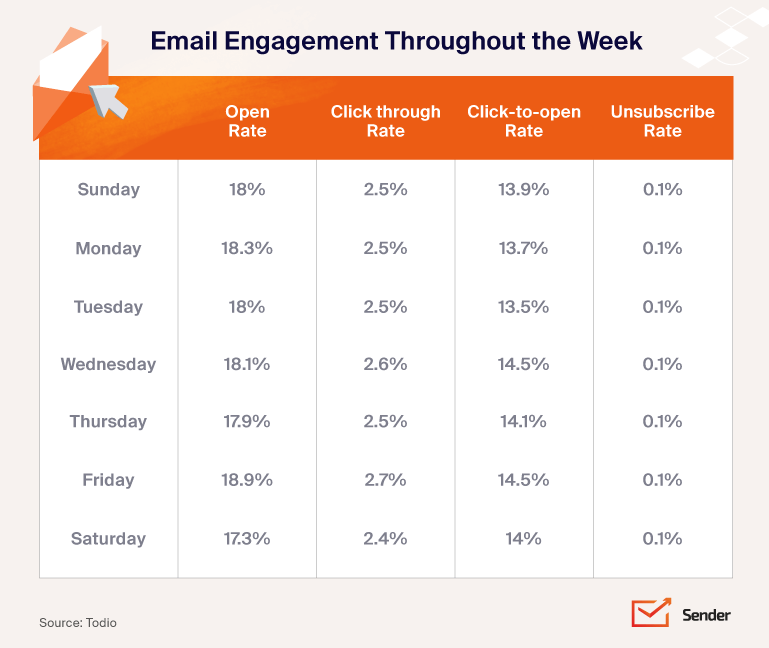
According to the data shared above, here are the best days of the week to schedule and send an email:
- Friday: Friday registers the highest open, click-to-open, and click-through rates.
- Wednesday: Wednesday is the second-best day to email if you consider all three metrics overall.
- Monday: Monday registers the highest open rates after Friday but has slightly lower click-to-open rates than Wednesday, so it comes at a close third.
Let’s look at when you should send an email each day of the week. Generally, the optimal time to send emails is when recipients are more likely to click-to-open.
According to post-pandemic data, high open rate email timing and click-to-open rates are registered late into the night after 11:00 p.m. for the US audiences, irrespective of the day. This confirms that people love to binge-watch (or scroll their mobile devices) in bed, late at night, and it can be the best time to send emails.
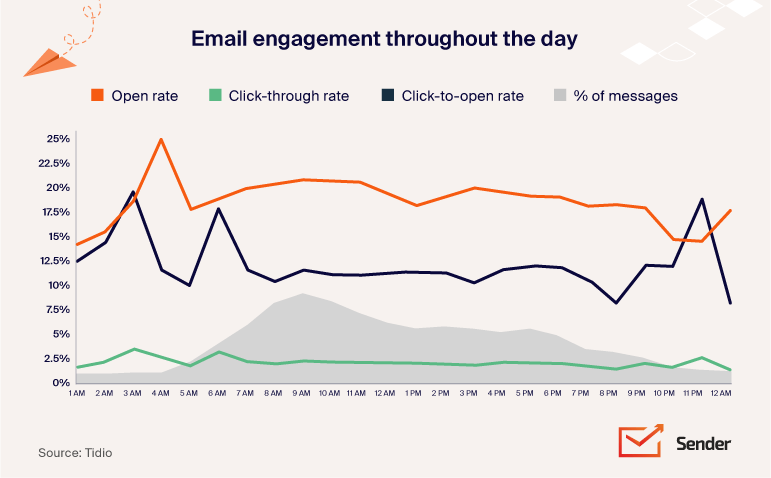
- On Friday: Existing data shows that the best time to send email blast on Friday is also when performance peaks. Friday sees the highest open rate at 18.90% and a strong click-to-open rate of 14.50%, making it the best day for email marketers. If you’re looking for the best time to send email on Friday, consider scheduling your emails between 10:30 p.m. and 12:00 a.m., or early in the morning between 3:00 a.m. and 7:00 a.m., especially if your audience is based in the United States.
- On Thursday: Research reveals that the best time to send email marketing on Thursday is also a strong opportunity for marketers, with up to 17.90% open rate, close to Friday’s open rates. The best time to send email on Thursday is between 2:30 a.m. and 5:00 a.m. for your subscribers in the US. However, the best time to send emails on Thursday can extend into early afternoon for certain industries.
- On Wednesday: Knowing the best time to send email blast on Wednesday is especially useful when targeting high click-to-open rates. It registers a click-to-open rate equal to that of a Friday. The best time to send email on Wednesday is late into the night, same as Friday—between 10:30 p.m. and 4:00 a.m. if you have a subscriber base in the US, though the best time to send emails on Wednesday may vary by audience type.
- On Tuesday: Being aware of the best time to send email campaign on Tuesday is good for achieving nice open rates but fails to get decent click-to-open rates. When tested, the best time to send email on Tuesday registered the lowest COR during the week. If you still choose to send emails on this day, the best time to send emails on Tuesday is between 9:00 a.m. and 11:00 a.m.
- On Monday: The best time to send email on Monday comes close to Friday regarding open rates. However, even though Monday emails have a good open rate, they have a lower click-to-open rate, which means lower chances of high conversion. Coming to the best time to send email on Monday, you should schedule an email between 11:00 p.m. and 4:00 a.m. for US audiences.
- On Saturday: If you’re wondering about the best time to send emails on Saturday, it’s important to weigh both the benefits and the drawbacks. Saturday scores excellent in the click-to-open rate but has lower open rates than other days of the week. So, you should consider it before scheduling an email on a Saturday.
- On Sunday: The best time to send email on Sunday is past noon and it performs better than Saturday regarding click-through and open rates. But as people might be in the ‘entertainment zone,’ they convert less than on other days.
Best Time to Send Emails FAQs
When should you send a cold email?
Recipients are likelier to click cold emails when they appear on top of their inboxes. So, send them out early in the morning, between 5:00 a.m. and 9:00 a.m., so that it would be read during business hours. As they settle down to open their work emails, the recipients are more likely to open and respond to your emails.
What is the best time to send email to get a response?
You should send an email when the CTR is the highest if you’ve planned a campaign to get a response from your customers. According to the latest data, the best time to send an email to get a reply is at 10:00 a.m. on a Tuesday. Emails sent on a Tuesday at 10:00 a.m. generally have the highest engagement rates.
When is the optimal time to send an abandoned cart email?
There is no specific day or time to contact your customers when sending abandoned cart emails. Regardless of the day, send your first abandoned cart email within 60 minutes of the customer abandoning the cart. That ensures the recipient can respond to the email before returning to the next task, getting your website off your head, or walking away altogether.
Look for the section about transactional email above to learn a proven abandoned cart email sequence with email send time optimization for scheduling such emails.
